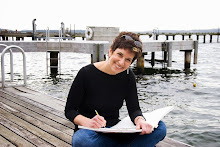Joanne's Website I had a recent conversation where a good friend seemed surprised when I said I would only paint from photos I had taken*. I added that it was very important to me that I had been there, had the experience and felt a strong emotional tug about the scene. So that led me to think that I bet many people who are NOT artists might think that artists choose what to paint by what sells, what's popular or hip in colors that are this year’s biggest hues. They might think artists simply scroll around the internet or magazines for images they like and then paint them exactly as they are presented. But you know what? That isn’t how most artists work. Most are compelled to paint what they paint. They might start with pulses of images or ideas that flash through their heads right before sleep. Then perhaps they sketch it around a bit or set up a photo-shoot or still-life. Some paintings are spurred by photographs like this one of women heading to work at a hotel at a tourist town in Mexico. Certain strong images are sort of burned into your head- whether you get them by sketches or photographs. And when they don’t go away, you work it into a painting. A painting is as much about the artist as it is about the subject matter—and if you can see that in the painting, then it’s a keeper. "We Take the Hill", 18x24" oil on cradled hardboard by Joanne Shellan
Exceptions being commission work
Friday, February 12, 2010
Sunday, February 7, 2010
Cabo Boats
Joanne's Website Every once in a while, if you're really lucky, you hit on a teacher or mentor who is just right for where you're at right now. Other teachers may have had the right message but you weren't ready to own it yet. Or you wanted to learn one set of things and the teacher seemed to be heading up a different path. I count my lucky stars every day because I have a great teacher right now in Liana Bennett. Before I started this boat painting, she emphasized to me how the very beginning stage is the MOST important part. Spend loads of time coming up with a solid composition & lightly block it in so you have little invested in the drawing—then when you need to swab the deck clean with turpentine, you won’t cry because your gorgeous drawing is getting wiped out. Take time to thinly block in the correct values and colors. Stand twenty feet back now and look at it. Test how the eye is led through the piece. Figure out the problems and fix them before you get into the depth of the painting. So three hours later, I brought home only the beginning scratches of this painting but I had done as my teacher recommended. Her advice is great and I hope you can use it too. Get lucky!
Wednesday, February 3, 2010
Good Cherry Pie
Joanne's Website Be dogged. Be persistent. Stick with it and you might yet get it~! That's the carrot that always keeps me going. I went back into this painting a third time and finally I'm satisfied. What do you think? Isn't it better than the last post? Let me tell you a little painter's secret; the absolute best part of a painting is at the very, very end when you get to put in your lightest lights and highlights! Oh joy! The painting comes to life under these final but important strokes. The difference between last week's cherry pie and this re-do is that this one has unified strong light and dark areas. The last version was muddled and less defined. Clearly defined and persistent are our words for today.
Subscribe to:
Posts (Atom)



